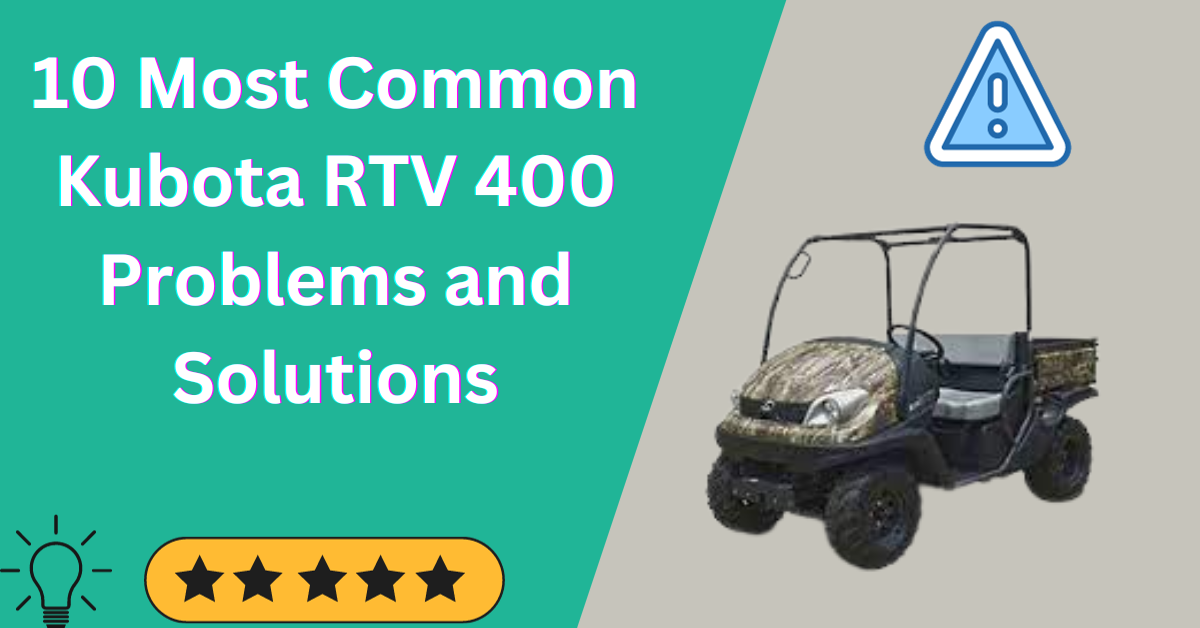Are you going to buy a Kubota RTV 400? Or do you already own it? Well, then you must be facing some issues with this utility vehicle. We have seen a lot of owners complaining about the Kubota RTV 400 and want solutions for it.
The most common Kubota RTV 400 problems are overheating, electrical problems, transmission troubles, brake problems, suspension concerns, oil leaks, fuel system issues,tire and wheel problems, steering difficulties and exhaust.
So, we are going to discuss these problems one-by-one with their easy solutions. Keep reading the article to know more about this vehicle.
10 Kubota RTV 400 Problems and Solutions:
Here we discuss the 10 most common problems with Kubota RTV reported by owner.
1. Kubota RTV 400 Overheating problems
The engine can sometimes overheat, leading to performance issues and potential damage.
Solution: Check the coolant level and ensure proper circulation. Clean the radiator and cooling system to prevent clogs. Consider upgrading to a higher-capacity radiator if overheating persists.
2. Electrical Problems
Wiring issues or electrical component failures can lead to starting problems, lighting issues, and more.
Solution: Inspect wiring for damage, fraying, or loose connections. Test fuses and relays. Replace faulty components as needed.
3. Kubota RTV 400 Transmission Problems
Some users have reported transmission problems, such as shifting difficulties or slippage.
Solution: Check transmission fluid levels and condition. If shifting issues persist, consult a professional mechanic for transmission diagnosis and repair.
4. Brake Problems
Brake issues, including brake pad wear or hydraulic system problems, can affect stopping power.
Solution: Inspect brake pads, rotors, and hydraulic lines. Replace worn components and bleed the brake system if necessary.
5. Suspension Concerns
In the list of kubota RTV 400 problems, suspension concerns is one of the major problem reported by owner. In this problem, suspension components might wear out, causing a rougher ride or give handling problems.
Solution: Inspect suspension components for wear and damage. Replace worn parts and consider upgrading to heavy-duty components for a smoother ride.
6. Oil Leaks
Leaking oil can be a sign of gasket or seal problems, potentially leading to engine damage.
Solution: Identify the source of the leak and replace faulty gaskets or seals. Regularly monitor oil levels to prevent damage to the engine.
7. Fuel System Issues
Fuel delivery problems can lead to poor performance, stalling, or difficulty starting.
Solution: Check fuel filters and lines for clogs. Test the fuel pump’s functionality. Check for any leakage in the fuel system. If there is any, put pressure on it to stop it.
8. Tire and Wheel Problems
Tire wear, punctures, or alignment issues can impact ride quality and handling.
Solution: Inspect tires for wear and damage. Replace damaged tires and ensure proper tire pressure and alignment.
9. Steering Difficulties
Steering problems can affect maneuverability and control. You can find it hard to move the steering wheel which can cause issues during driving.
Solution: Check power steering fluid levels and the steering system for any loose or damaged components.
10. Exhaust and Emissions
Emission control system problems can lead to issues with exhaust emissions and engine performance.
Solution: Inspect the exhaust system for leaks and damage. Replace worn-out components and address any emissions-related error codes.
Keep in mind that not all vehicles will experience these problems, and regular maintenance can help prevent many of them. If you’re experiencing any issues with your Kubota RTV 400, it’s recommended to consult with a qualified mechanic or authorized dealer for diagnosis and repairs.
5 Tips to Maintain your Kubota RTV 400:
Here are five tips to help you maintain your Kubota RTV 400:
1. Regular Maintenance Schedule
Follow the manufacturer’s recommended maintenance schedule. This includes oil changes, fluid checks, filter replacements, and other routine tasks. Regular maintenance can prevent many issues and prolong the vehicle’s lifespan.
2. Keep it Clean
Clean your RTV regularly, especially after off-road use. Mud, dirt, and debris can accumulate and lead to corrosion or component damage. Regular cleaning also makes it easier to spot any potential problems.
3. Inspect and Lubricate
Routinely inspect your vehicle for signs of wear, damage, or leaks. Check components like the brakes, suspension, steering, and tires. Also, keep an eye on the lubrication points and ensure they are properly greased.
4. Proper Storage
If you’re not using the RTV for an extended period, store it in a dry and covered area to protect it from the elements. If possible, keep it elevated on blocks to prevent tire damage and flat spots.
5. Use Quality Parts
When replacing parts, use genuine Kubota parts or high-quality aftermarket parts that meet the manufacturer’s specifications. This ensures proper fit, performance, and longevity.
Remember that preventive maintenance is key to avoiding costly repairs down the line. Following these tips and consulting your vehicle’s manual will go a long way in keeping your Kubota RTV 400 in good condition. If you’re uncertain about any maintenance tasks, don’t hesitate to seek guidance from a professional mechanic or a Kubota dealer.
FAQs About Kubota RTV 400 Problems:
Q: How many hours is Kubota RTV?
Ans: A well-maintained Kubota vehicle could last between 4500 and 5500 hours.
Q: Is the Kubota RTV gas or diesel?
Ans: It has an air-cooled, single-cylinder gasoline engine.
Q: Where is the Kubota RTV made?
Ans: They are manufactured in Gainesville, Georgia which is near Atlanta.
Final Talk About Kubota RTV 400 Problems:
To conclude this whole conversation, we want to say that the Kubota RTV 400 can be beneficial for you in a lot of aspects. But, you need to keep it maintained and resolve the issues as soon as possible.
We hope this article has helped you in understanding and resolving the issues of your vehicle.










